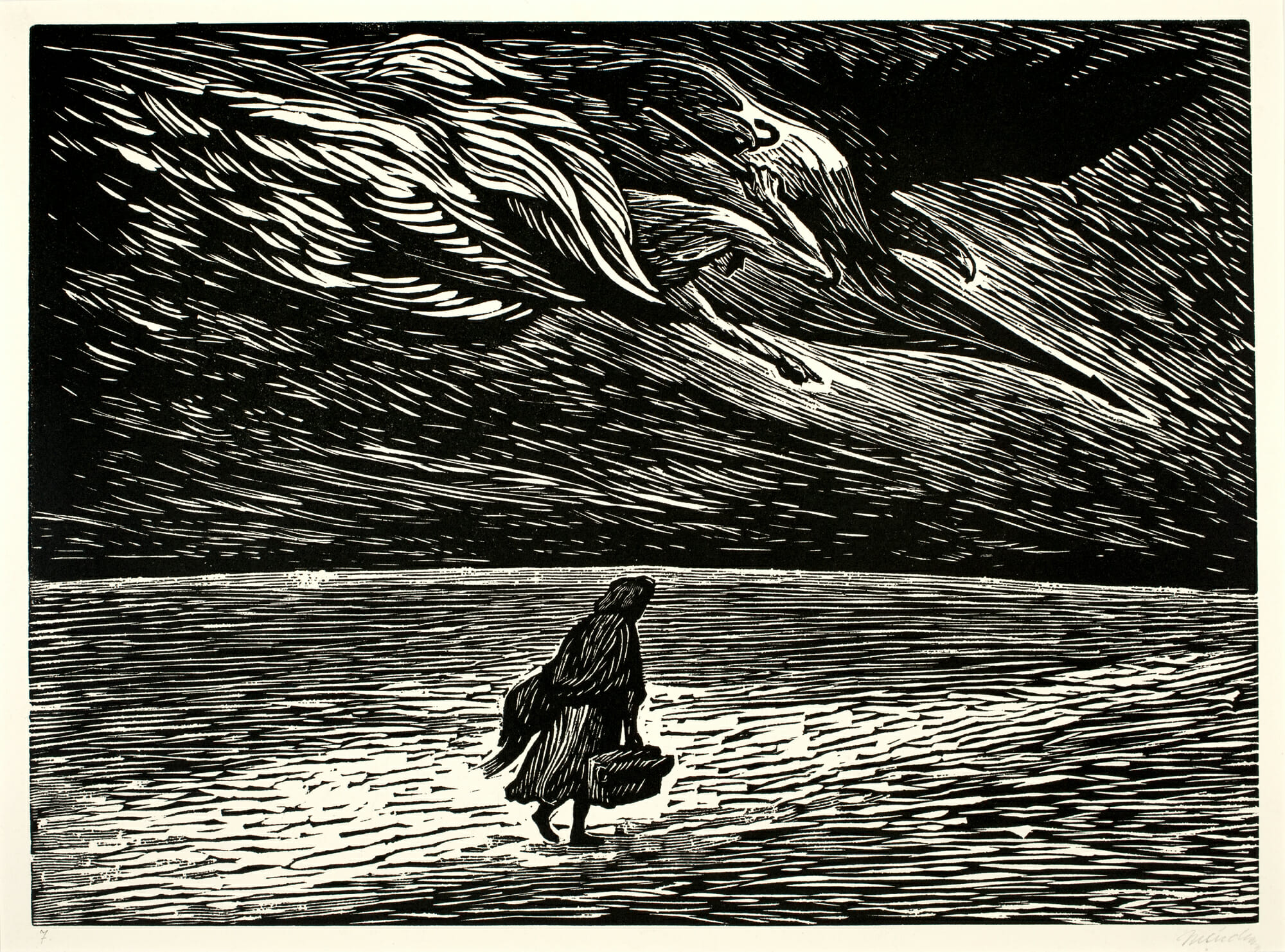
Leopoldo Méndez
Pequeña maestro, ¡qué inmensa es su voluntad!/Little school teacher, how great is your will!
This relief print, created as a backdrop for the opening and closing credits of the 1947 Mexican film Río Escondido, portrays the singular determination of a young school teacher. She walks alone carrying a valise across a stark landscape, appearing diminutive under a sky filled with symbolic shapes that seem to be her guides. The wings of an eagle offer safeguard, and an angel-like figure aims a finger and a flagstaff in the direction she is heading. Another, smaller eagle holds a serpent in its beak, an image familiar to all citizens of Mexico as the central feature of their country’s national flag, symbolizing the founding of the Aztec city of Tenochtitlan (now Mexico City). According to legend, their gods inspired the Aztec people to find an eagle holding a serpent in its beak perched on a cactus in the place they would choose as their homeland. The flag with its central icon has heralded Mexico’s progress toward independence and democratic self-rule since its autonomy from Spain in 1821. In this print, the flag allusion signals the advancement to which the schoolteacher is committed. Themes of resoluteness and tenacity, forward development, educational opportunity, and cultural imperative are all implied.
Méndez cut his image for Río Escondido into a linoleum block, gouging a multitude of short, expressive strokes and then rolling black ink on its surface, leaving the gouged lines free of ink. These resulting white areas appear as reflected light and textures in the landscape. Méndez wanted the original prints that he made for several movies to be like moving murals that could reach more people than murals on public buildings. As described by cinematographer Gabriel Figuero, Méndez would be shown a just-completed film and would interpret the theme in linocut prints for use as backgrounds for the film credits. “Then we would photograph them and put them on the screen. First just the print, without any letters on top, so that the audience could admire it at the size of the screen. It was a totally new possibility, seeing a print enlarged to this size, it was a real mural.” The prints were also sold as individual works of art.
The Artist
Leopoldo Méndez
Leopoldo Méndez is considered the finest printmaker in the history of Mexico. In 1937 Méndez, Luis Arenal, and Pablo O’Higgins founded the Taller de Gráfica Popular (Peoples’ Graphic Workshop) in Mexico City, which was active through the 1960s and produced thirty-five major portfolios of woodcuts, linocuts, and lithographs. The TGP was grounded in a belief in art’s capacity for social protest and the betterment of the nation’s people.
Méndez was born in Mexico City, one of eight children, to a shoemaker father and a farm worker mother who was of indigenous Nahua heritage. His parents died before he turned two years old and he was raised primarily by his aunt. He became interested in drawing in primary school and he later related that he had competed with another boy in his class to be the best at drawing battleships. His father’s family had been activists—his paternal grandfather died in a battle during the French intervention in Mexico and his father resisted the Porforio Diaz regime, resulting in the burning of his store. Méndez became politically active, supporting the goals of the Mexican revolution but working quietly and mostly anonymously, opposing the concept of making art for profit due to his belief that the true value of art was its social utility. An artist whose whole life was influenced by the early violence and moral promises of his country’s revolution, Méndez continually worked in collaboration with other artists to express his belief in the revolution’s vision.
Key Ideas
- Knowledge and determination as forces for challenging ignorance and oppression
- Forward progress founded upon cultural heritage and identity
- Art as an instrument for political protest and educational advancement
Discussion Questions
- What are some of the first things you notice as you look at this print? Why do you think your eye is drawn to these aspects?
- What are your ideas about the walking figure? Where does it seem to be? What feelings seem to be conveyed by the shape of the body? What feelings do you experience when you contemplate this image? What might be some thoughts this person is pondering? What story can you imagine from looking at this image?
- How are lines and the contrasts of black and white used to convey landscape, the sky, the time of day, and weather? What do you think might be some symbolic meanings of the lighted path?
- Once you know that a major goal of the Mexican Revolution, which deeply influenced the artist, was to promote education of all the populace, how does the image of a school teacher determinedly walking alone in the face of turbulence seem symbolic? What are your thoughts about the artist’s aim to arouse compassion for the people he portrayed?
- The film Río Escondido (Hidden River), directed by Emilio Fernández, tells the story of an idealistic rural school teacher who urges the people of a village to resist a despotic leader who is denying them their rights to schooling and to their supply of water. In the conclusion, the formerly hopeless residents unite in an armed struggle against their oppressor. In what ways are the themes of this film suggested in Pequeña maestra, ¡que immense es su voluntad! (Little school teacher, how great is your will!)? How does this story parallel the history of the country of Mexico?

